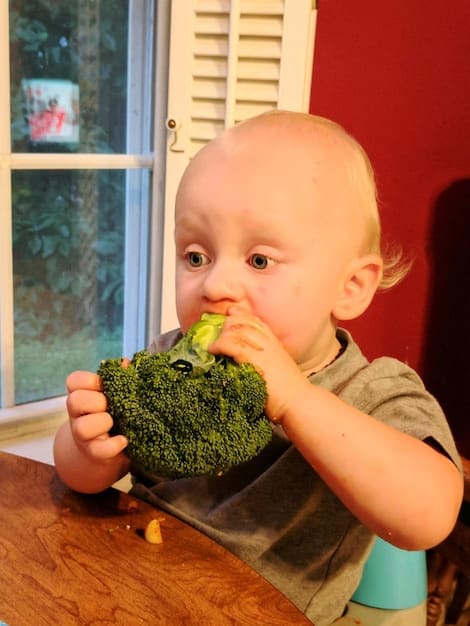Baby-Led Weaning: Top 5 Mistakes and How to Avoid Them

Baby-led weaning (BLW) offers numerous benefits, but parents often make mistakes such as starting too early, offering unsafe foods, not monitoring iron intake, panicking over gagging, and lacking variety; understanding and correcting these errors is crucial for a safe and successful BLW journey.
Embarking on the baby-led weaning (BLW) journey can be an exciting yet daunting experience for parents. It’s a method that encourages babies to feed themselves solid foods from the start, fostering independence and healthy eating habits. However, like any parenting approach, it comes with its own set of challenges. In this article, we’ll explore baby-led weaning: 5 common mistakes parents make (and how to fix them), ensuring a smoother and more successful transition for both you and your little one.
What is Baby-Led Weaning?
Baby-led weaning (BLW) is an approach to introducing solid foods that skips traditional spoon-feeding. Instead, babies are offered appropriately sized and textured pieces of food that they can pick up and eat themselves. This method is typically introduced around 6 months of age, when babies show signs of readiness for solids.
The core principle of BLW is to allow babies to explore food at their own pace, developing their motor skills, hand-eye coordination, and a positive relationship with food.
Benefits of Baby-Led Weaning
One of the main advantages of baby-led weaning is that it encourages self-regulation. Babies can control their intake based on their hunger cues, which may reduce the risk of overeating and promote healthier eating habits later in life.
Another key benefit is that it promotes independence and confidence in eating. From the beginning, babies are actively involved in the feeding process, which can enhance their sensory exploration and acceptance of different foods.
- Encourages self-regulation of food intake.
- Promotes development of fine motor skills.
- Enhances sensory exploration and acceptance of diverse foods.
- Fosters independence and confidence during mealtimes.
In summary, baby-led weaning is a holistic approach to introducing solids that supports a baby’s development in numerous ways, from physical skills to healthy eating habits.

Mistake #1: Starting Too Early
One of the most common pitfalls in baby-led weaning is starting before your baby is truly ready. Introducing solids too early can lead to digestive issues and increased risk of choking. Readiness cues are essential to observe.
Knowing when your baby is ready can help to ensure a positive and safe introduction to baby-led weaning.
Key Readiness Cues
Before diving into BLW, make sure your baby exhibits key readiness cues. This typically occurs around 6 months of age. Babies should be able to sit upright with minimal support, have good head control, and show an interest in food. The tongue-thrust reflex, which pushes food out of the mouth, should also be diminished.
Attempting to start BLW before your baby meets these milestones can be frustrating and potentially dangerous.
- Sitting upright with minimal support.
- Good head control and stability.
- Showing interest in food by reaching for it.
- Diminished tongue-thrust reflex.
To avoid this mistake, closely monitor your baby for these readiness cues. Rushing into BLW before they’re ready can lead to unsuccessful and stressful mealtimes.
Mistake #2: Offering Unsafe Foods
The types of foods you offer during baby-led weaning are crucial for your baby’s safety. Certain foods pose a higher choking risk than others. Therefore, mindful selection and preparation are essential.
Knowing which foods to avoid and how to prepare safe options can help minimize the risk and give you peace of mind.
Foods to Avoid
Whole grapes, cherry tomatoes, nuts, popcorn, and hard candies are common choking hazards and should be avoided. These foods are difficult for young babies to manage safely in their mouths. Raw vegetables, such as carrots and apples, should be cooked until soft to reduce the risk.
Additionally, be cautious with foods that contain small bones, such as fish or chicken. Ensure all bones are removed before offering them to your baby.

Safe Food Preparation
Prepare foods by cutting them into long, finger-like pieces that are easy for babies to grasp. Steaming, boiling, or roasting until soft is ideal. Avoid adding salt, sugar, or honey to your baby’s food.
Experiment with a variety of textures and flavors to expand your baby’s palate, but always prioritize safety. Remember, the goal is to make mealtime enjoyable and safe for your little one.
- Cut foods into long, finger-like pieces.
- Cook fruits and vegetables until soft.
- Avoid adding salt, sugar, or honey.
- Remove bones from fish and chicken.
By being mindful of the foods you offer and how you prepare them, you can significantly reduce the risk of choking and create a more secure and enjoyable BLW experience.
Mistake #3: Not Monitoring Iron Intake
Iron is a critical nutrient for your baby’s development, especially once they start solids. Breast milk iron stores begin to deplete around 6 months, making it important to introduce iron-rich foods with BLW.
Understanding the importance of iron helps ensure that your baby receives the necessary nutrients for healthy growth.
Iron-Rich Foods
Good sources of iron include red meat, poultry, beans, lentils, and fortified cereals. Offering these foods regularly can help prevent iron deficiency. Combine iron-rich foods with vitamin C-rich options to enhance absorption. For example, pairing beef with bell peppers or lentils with tomatoes can boost iron uptake.
If you’re concerned about your baby’s iron intake, consult with your pediatrician.
- Offer iron-rich foods like red meat, poultry, and lentils.
- Combine iron-rich foods with vitamin C sources.
- Monitor your baby for signs of iron deficiency.
- Consult with your pediatrician if you have concerns.
Paying attention to iron intake is vital for your baby’s health during BLW. Incorporating iron-rich foods and monitoring for any signs of deficiency ensures optimal growth and development.
Mistake #4: Panicking Over Gagging
Gagging is a normal and essential reflex that helps babies prevent choking. However, it can be alarming for parents unfamiliar with the difference between gagging and choking. Knowing how to differentiate between the two can help you stay calm.
Understanding the difference between gagging and choking can ease your worries and allow you to respond appropriately.
Gagging vs. Choking
Gagging is a protective reflex where your baby pushes food forward in their mouth to prevent it from going too far back. It’s characterized by coughing, sputtering, and sometimes turning red. Choking, on the other hand, is when the airway is blocked, and the baby can’t cough or make any noise. It requires immediate intervention.
When your baby gags, remain calm and allow them to work through it. Intervention is generally not necessary. If your baby is choking, call emergency services immediately and administer first aid.
- Learn the difference between gagging and choking.
- Stay calm when your baby gags.
- Avoid intervening unless your baby is choking.
- Know basic infant first aid for choking.
Understanding the difference between gagging and choking is crucial for every parent. By remaining calm and knowing how to respond, you can handle these situations with confidence and ensure your baby’s safety.
Mistake #5: Lacking Variety
Offering a wide variety of foods is essential for developing your baby’s palate and ensuring they receive a balanced diet. Sticking to the same few foods can lead to nutritional deficiencies and finicky eating habits later on.
Exposing your baby to diverse flavors and textures can help them develop a healthy and adventurous approach to eating.
Introduce a Range of Foods
Introduce a range of fruits, vegetables, proteins, and grains. Rotate foods regularly to ensure your baby gets a variety of nutrients. Be patient; it may take multiple exposures for your baby to accept a new food. Don’t be discouraged if they initially reject it; keep offering it periodically.
Involving your baby in family meals can also encourage them to try new things. Seeing others enjoy a variety of foods can pique their interest and make them more willing to experiment.
- Introduce a variety of fruits, vegetables, proteins, and grains.
- Rotate foods regularly to ensure variety.
- Be patient; it may take multiple exposures for acceptance.
- Involve your baby in family meals.
Offering a diverse range of foods is a key aspect of successful baby-led weaning. This practice not only ensures your baby receives a balanced diet but also helps them develop a lifelong appreciation for healthy eating.
| Key Point | Brief Description |
|---|---|
| 👶 Readiness Cues | Ensure baby can sit upright, has head control, shows interest in food. |
| ⚠️ Safe Foods | Avoid choking hazards like whole grapes; cut foods into finger-like pieces. |
| 💪 Iron Intake | Offer iron-rich foods like meat and lentils; pair with Vitamin C for better absorption. |
| 😲 Gagging vs. Choking | Gagging is normal; choking requires immediate action. Know the difference. |
Frequently Asked Questions
▼
The ideal time is around 6 months, when your baby shows signs of readiness like sitting upright, good head control, and interest in food.
▼
Soft-cooked vegetables like broccoli and carrots, ripe fruits like avocado and banana, and strips of cooked meat are great starting options.
▼
Avoid small, round, hard foods. Cut foods into finger-like pieces and cook until soft. Always supervise your baby during mealtimes.
▼
It’s normal for babies to eat very little initially. Focus on letting them explore and get used to food. Breast milk or formula remains their primary source of nutrition.
▼
Continue offering a wide variety of foods and be patient. It can take many exposures for a baby to accept a new food. Don’t pressure them to eat it.
Conclusion
Baby-led weaning can be an incredibly rewarding experience. By understanding and avoiding these common mistakes, you can help your baby develop a positive relationship with food, foster independence, and ensure they receive the nutrients they need for healthy growth. Remember, every baby is different, so adjust your approach based on their individual needs and cues.




